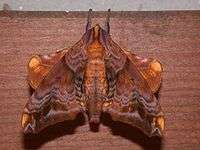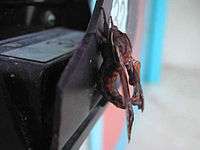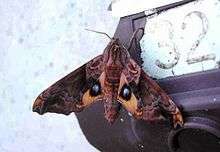Paonias myops
Paonias myops, the small-eyed sphinx, is a moth of the family Sphingidae. The species was first described by James Edward Smith in 1797. It is found from south-eastern Canada to Florida and westward almost to the Pacific Coast.[2] It is also known from Mexico.


| Small-eyed sphinx | |
|---|---|
 | |
| Scientific classification | |
| Kingdom: | Animalia |
| Phylum: | Arthropoda |
| Class: | Insecta |
| Order: | Lepidoptera |
| Family: | Sphingidae |
| Genus: | Paonias |
| Species: | P. myops |
| Binomial name | |
| Paonias myops (J. E. Smith, 1797)[1] | |
| Synonyms | |
| |
The wingspan is 52–69 mm. Adults are more nocturnal than most sphingids; after an initial bout of activity after dusk, they fly throughout the night. Adults are on wing from June to September in eastern Canada. In New Jersey, there are two generations per year and there are four generations in Louisiana.
Subspecies
- Paonias myops myops
- Paonias myops occidentalis Clark, 1919 (Mexico)
gollark: It's not. I told you 30 minutes ago, then erased your memory of it through orbital mind control lasers.
gollark: Actually, I am Bill Gates.
gollark: Well, as an immortal person it's a bit redundant, but yes.
gollark: Dying is *very* uncool, so logically not dying is highly cool, so immortality is the correct option.
gollark: Well, if I needed one, which I don't, obviously both those options are boring and I should be put into a polar orbit around Saturn.
References
- "CATE Creating a Taxonomic eScience - Sphingidae". Cate-sphingidae.org. Archived from the original on 2012-12-20. Retrieved 2011-11-01.
- "Paonias myops (J. E. Smith, 1797)". Sphingidae of the Americas. Retrieved 2011-11-01.
- Fullard, James H. & Napoleone, Nadia (2001): Diel flight periodicity and the evolution of auditory defences in the Macrolepidoptera. Animal Behaviour 62(2): 349–368. doi:10.1006/anbe.2001.1753 PDF fulltext
External links
- Lotts, Kelly & Naberhaus, Thomas (2017). "Small-eyed sphinx Paonias myops (J.E. Smith, 1797)". Butterflies and Moths of North America. Retrieved December 19, 2018.
- Midnight racer on National Geographic.
This article is issued from Wikipedia. The text is licensed under Creative Commons - Attribution - Sharealike. Additional terms may apply for the media files.